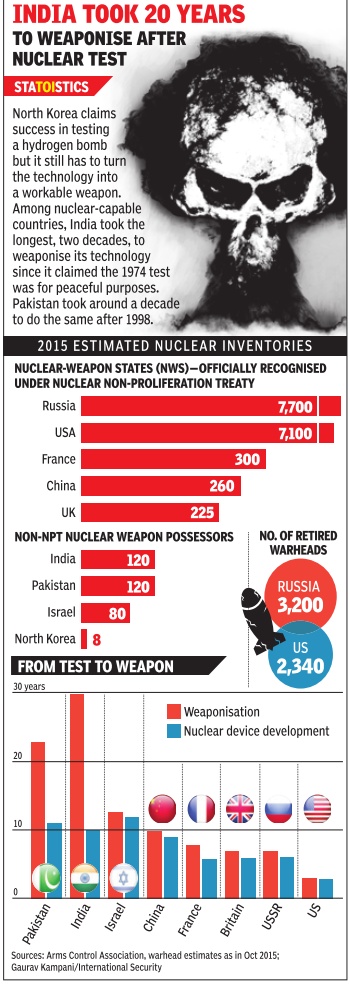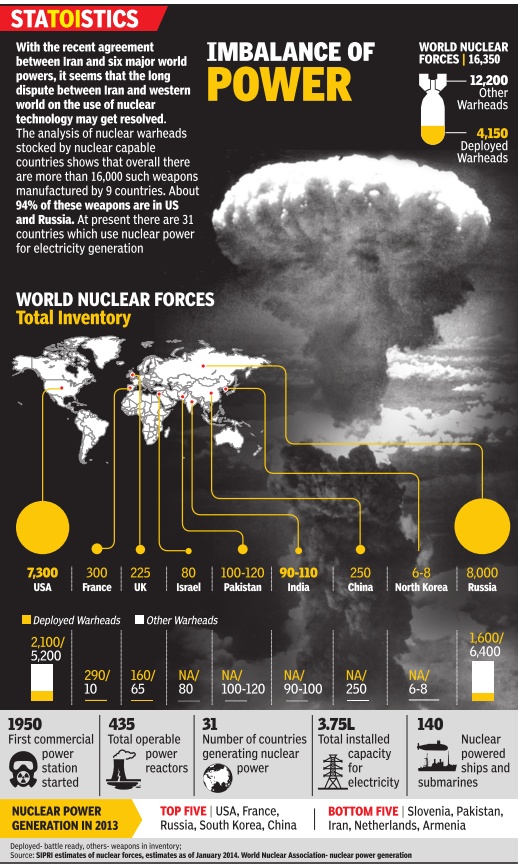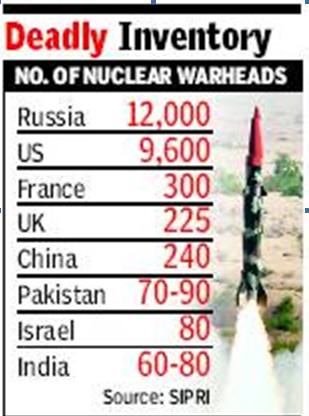Nuclear arsenals: India, China, Pakistan
(→Nuclear tests) |
|||
| Line 1: | Line 1: | ||
| + | [[File: Nuclear weapons in India, Pakistan and the world.jpg| Nuclear weapons in India, Pakistan and the world.i) Nuclear inventories in 2015. Ii) The number of years each country took between nuclear device development and weaponisation; Graphic courtesy: [http://epaperbeta.timesofindia.com/Gallery.aspx?id=14_01_2016_010_017_001&type=P&artUrl=STA-TOI-STICS-INDIA-TOOK-20-YEARS-TO-14012016010017&eid=31808 ''The Times of India''], January 14, 2016|frame|500px]] | ||
{| class="wikitable" | {| class="wikitable" | ||
|- | |- | ||
Revision as of 01:57, 20 January 2016

This is a collection of newspaper articles selected for the excellence of their content. |
Contents |
Nuclear tests

The Times of India, Sep 18 2015
The Comprehensive Test Ban Treaty aimed at banning nuclear tests is criticised as a tool of the nuclear haves to maintain their monopoly. Data shows that 2,045 of the 2,053 nuclear tests so far have been by five countries the US, Russia, France, UK and China. After its split from the Soviet Union, Ukraine signed the Budapest Memorandum (with the US, UK and Russia) and handed over its nuclear arsenal to Russia in return for a perpetual guarantee of sovereignty and territorial integrity. Experts argue that the 2014 Russian annexation of the Ukrainian territory of Crimea might not have happened if Ukraine had retained these weapons.
India, China, Pakistan: nuclear arsenals
India, China, Pak add to nuke arsenal
Chidanand Rajghatta
China, India, and Pakistan bumped up their nuclear arsenal, adding 10 to 20 weapons each in 2012, a handbook released by arms watchdog SIPRI noted.
India increased its nuclear warheads from 80-100 in 2012 to 90-110 in 2013, keeping pace with Pakistan, which went from 90-110 weapons to 110-120. China piled up 10 more weapons from 240 in 2012. “India’s expansion of missile capabilities isn’t targeted at Pakistan, but at China,” a SIPRI staff said
The status in 2012
With eye on China, India ramps up N-arsenal
SIPRI Says Delhi, Beijing And Islamabad Added 10-20 Weapons Last Year
Chidanand Rajghatta TNN
Washington: China, India, and Pakistan all added 10 to 20 nuclear weapons to their arsenal last year even as the top four nuclear nations — US, Russia, UK and France — appear determined to retain their nuclear arsenals indefinitely even if they didn’t add to their inventory, the Swedish arms watchdog SIPRI said in its 2013 handbook.
SIPRI’s world nuclear forces chart showed India bumping up its nuclear warheads from 80-100 in 2012 to 90-110 in 2013, keeping pace with Pakistan, which went from 90-110 weapons to 110-120. China, in the meantime, went from 240 nuclear weapons in 2012 to 250 in 2013.
However, SIPRI said, Russia and the US, along with the three other nuclear powers — France, Britain and China — are either deploying new nuclear weapon delivery systems or have announced programmes to do so, and appear determined to retain their nuclear arsenals indefinitely.
As a result, although the total number of nuclear weapons in the world dropped from approximately 19,000 in 2012 to 17,265 in 2013, there was little to inspire hope that states are genuinely willing to give up their nuclear arsenals, the SIPRI report said.
With greater insecurities and fears of survival, Pakistan is long thought to possess more nukes than India, although suggestions that it has or will overtake the weapons count of Britain and France seem misplaced. India, on the other hand, appears to be ramping up its arsenal with China in its calculations since Pakistan’s smaller land mass has few targets.
“With India we see the gradual expansion of its longer-range ballistic missile capabilities which are not really targeted at Pakistan but rather at China,” Kile said.
Nuclear arsenal: India, Pakistan
Pak’s nuke arsenal bigger than India’s
Rajat Pandit
New Delhi: After racing past India in ballistic and cruise missiles, with covert help from China and North Korea, Pakistan seems to be surging ahead on the nuclear front too.
A series of recent estimates by international nuclear watchdogs and reputed thinktanks hold that Pakistan has 70-90 warheads compared to India’s 60-80. China has around 240 warheads.
Even as global fears about the possibility of jihadis gaining access to Pakistan’s nuclear arsenal, enriched uranium or technical know-how continue, its deadly inventory is only going to expand. Pakistan, after all, is supplementing its ongoing enriched uranium-based nuke programme with a weaponsgrade plutonium one. Its two new heavy-water reactors being built at Khushab nuclear facility, with China’s help, are geared towards producing weapons-grade plutonium, as reported by TOI earlier. 100 Pak nukes at short notice? New Delhi: The Stockholm International Peace Research Institute (SIPRI)’s latest annual world military expenditure report, released on Wednesday, estimates Pakistan’s stock of nuclear warheads to be at least 10 more than that of India’s. The report also said Pakistan’s weapons-grade plutonium production would jump seven-fold with the two new reactors at Khushab nearing completion.
“Our conservative estimates are that Pakistan has 60 warheads and could produce 100 nuclear weapons at short notice,” said SIPRI, adding that Islamabad had earmarked its US-supplied F-16 fighters, Ghaznavi and Shaheen missiles as its nuke delivery systems.
India’s nuclear weapons programme, in turn, has largely been plutoniumbased, basically centred around the Pu-239 produced in research reactors like Cirus and Dhruva at Bhabha Atomic Research Centre. Nuclear arsenals of India, Pakistan, and even China, pale in comparison to the gigantic ones of the two former Cold War foes, US and Russia. SIPRI estimates there are a whopping 22,600 active, inactive and stored nuclear warheads around the globe, enough to destroy it several times over.
While Russia has 12,000 warheads, 4,630 of them ‘‘deployed’’ ones, US has 9,600, which includes 2,468 of them operational.
2012: Nuclear arsenals around the world


